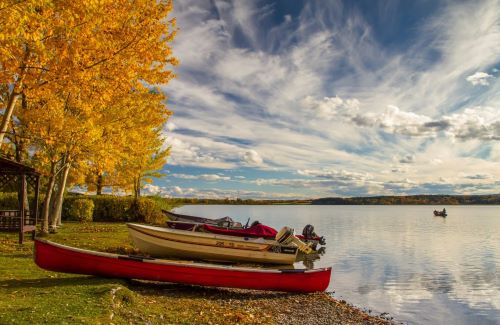British Columbia is world-renowned for its range of fishing experiences. From fighting chinook salmon in the Skeena to world-class fly-fishing for westslope cutthroat trout in the Kootenays, and excellent small-lake fisheries for rainbow trout throughout the province, there is a plethora of opportunities for even the most avid anglers. It’s possible to fish every month of the year in B.C. In this guide, we’ll share when and where the bite is on – January through December.
You can use this guide to plan your approximate calendar for the year ahead, and optimize both your time on the water and number of hook-ups.
Note: The above table does NOT indicate whether the stream or fishery is open for recreational angling; please check the current salmon openings, closures and limits on the Department of Fisheries and Oceans website, and the Freshwater Fishing Regulations for other freshwater species. Ice-off dates vary from year to year; timings given in the table are rough approximations on when lakes in a region are usually ice-free.
January
For many, chilly January is a time to snuggle up with a good book and watch the snow fall. For keen anglers, the action is outside.
- By January, the ice is thick enough on many lakes to support ice-fishing. Depending on your location, rainbow, brook, and lake trout, kokanee, perch, walleye, northern pike, and burbot are some of the species available to catch.
- In coastal rivers and sloughs, egg-eating gamefish like coastal cutthroat and bull trout are feasting on the remains of the fall salmon run, and can be caught using a fly or spinning rod. Note that this fishery is catch-and-release only, as all wild trout and char caught in streams in Regions 1 and 2 must be released.
- Experienced anglers can try their hand at winter-run steelhead, which return in limited numbers to the rivers of the Lower Mainland (Chilliwack/Vedder and Chehalis), and Vancouver Island (Cowichan and Stamp). In northern B.C., try the Kitimat and Kalum rivers. Keep in mind that since all wild steelhead must be released, fish should be handled with care.
February
There’s fishing, and there’s preparing for fishing. February is a good month to tie flies and get organized for the season ahead. Clean up and prepare your tackle boxes, rig your rods, and make plans for the spring fishing season that is just around the corner.
- Since ice-fishing for kokanee peaks later in the season than for rainbow and brook trout, February can be a great time to target these landlocked sockeye salmon. Try deeper waters, and make sure to tie a big (hookless) spoon ahead of your lure or bait to act as an attractor for these curious fish.
- Ice-fishing for burbot is best from December to March, when they move from the depths of the lake into the shallows to spawn. As these bottom-feeders are more active at night, try heading out for a moonlit excursion.
- Winter steelhead fishing continues, with peak run times through to early May.
- It’s possible to fish open waters of lakes in low-lying areas of coastal southern B.C., but fish are typically lethargic at this time of year. Try fishing stocked lakes with a fishing-float setup, or a buoyant artificial bait suspended 30 to 60 centimetres (one to two feet) off the bottom. For fly anglers, a balanced leech suspended under a strike indicator is a good option.
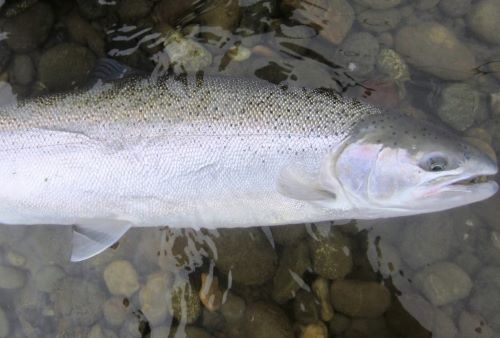
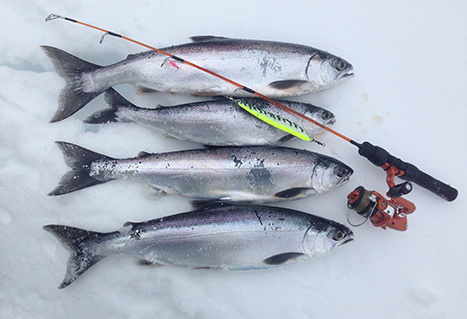
March
Lakes in southwestern B.C. are stocked with rainbow trout, and ice-fishing success can improve as water temperatures warm and fish become more active.
- Ice-fishing season winds down as the ice melts. Fishing can often be good right at the end of the season, but make sure you are vigilant about checking ice thickness at this time of year.
- Cutthroat and rainbow trout in coastal rivers are feeding on hatching salmon fry, and can be a fun fishery to tide you through until stillwater season.
- Stocking of lakes in the Lower Mainland and on Vancouver Island begins in March – perfect time to fish for families, novice anglers, and keeners wanting to scratch that fishing itch.
- In the Lower Mainland and on Vancouver Island, along with certain lakes in the Kootenays and Okanagan where regulations allow, March and April are great months to target invasive smallmouth bass. These fish are getting ready to spawn, and will aggressively strike almost any lure put in front of them.
- Although the non-tidal fishing licence year runs from April 1 to March 30, anglers can purchase pre-season basic freshwater fishing licences beginning March 1.
April
April 1 is the official start of the freshwater fishing season. Spring is here, along with excellent lake fishing.
- With the stocking program well underway in southern B.C., April is one of the best months to target urban fisheries within a short drive of Nanaimo, Victoria, and Vancouver. Around the province, other lakes are stocked with yearlings and fry.
- Depending on weather, ice is starting to come off lakes in the B.C. Interior, and lakes are experiencing turnover.
- Lower-elevation lakes are a top choice right now.
- Winter-run steelhead season in the Skeena region begins once the ice covering rivers starts to melt, usually in late April. Remember your Classified Waters Licence.
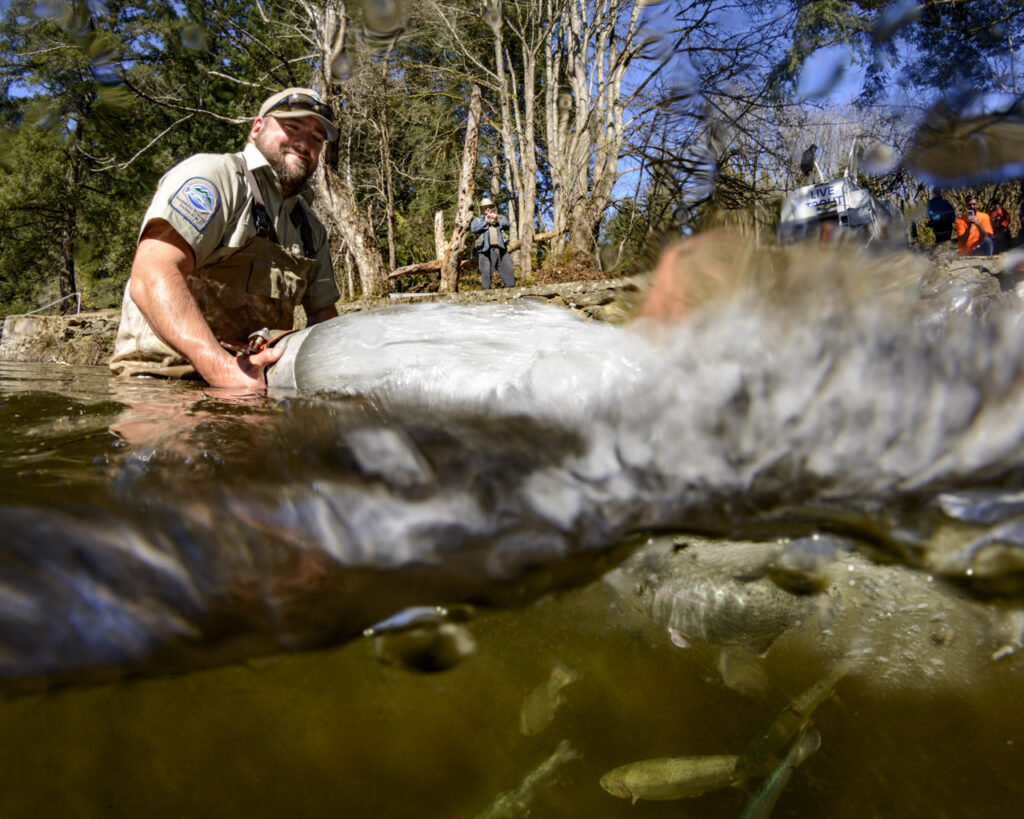
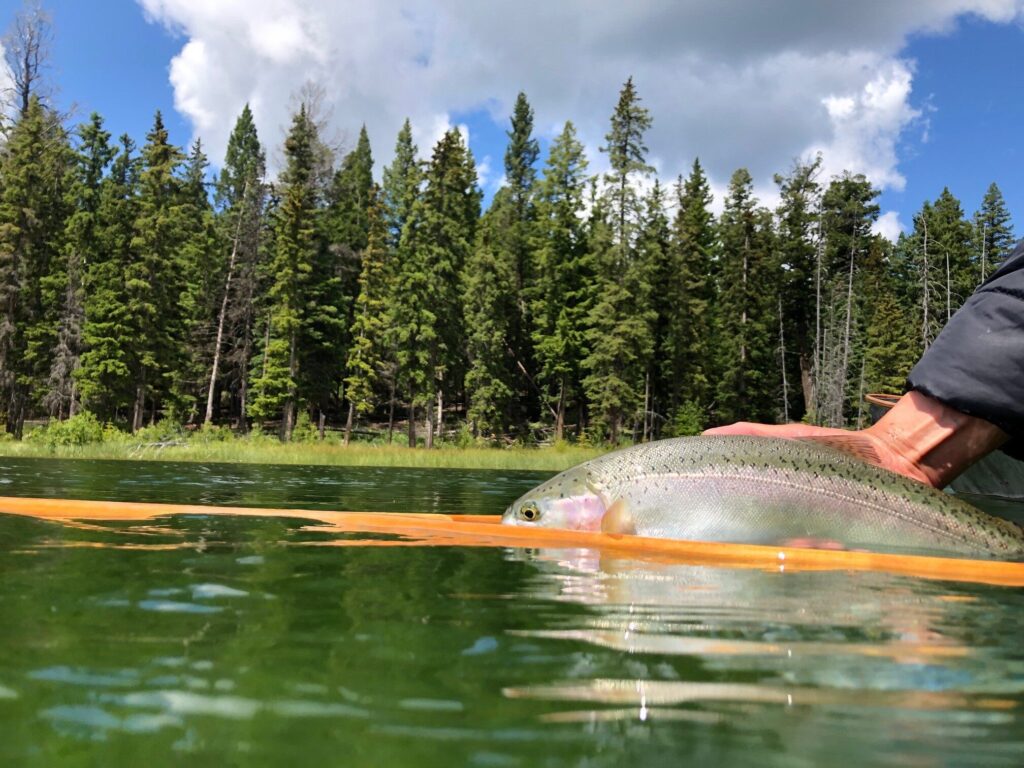
May
May is possibly the best month for stillwater fishing in B.C. Lake temperatures are warming, insects are hatching, and trout are feeding voraciously after a long winter.
- By May, the ice has melted on most interior and northern lakes; they are in prime condition for rainbow trout fishing. Early in the season, chironomid, shrimp, and leech patterns are some of the insect presentations that fly-fishers should be using.
- Spring freshet causes river levels to surge, and many streams are not fishable during this time. In the north, freshet is a bit later (usually June).
- A unique run of coho salmon enters the Capilano River in North Vancouver from mid- to late May.
- Chinook start entering the Kitimat River system in the Skeena region in May, and fishing can be excellent until the end of July.
June
Another stellar month to be fishing B.C. waters!
- In late June, many rivers in northern B.C. are blown out due to spring runoff – but that’s okay. Since insect hatches trail slightly behind those in the south of the province, June is a peak month for fishing northern stillwaters instead.
- The bite is on in B.C. lakes. With a smorgasbord of insect hatches to choose from, there is exceptional fishing for rainbow trout in stillwaters.
- June 15 is opening day for most rivers in the Kootenay region (see water-specific tables for additional closed times or exceptions). Targeting bull trout and whitefish with streamers and spoons can be very productive.
- In our province’s Omineca and Peace regions, troll or fly-fish in one of the large lakes. Walleye, mountain whitefish, rainbow trout, arctic char, brook trout, lake trout, bull trout, Dolly Varden, and northern pike are among the species that can be caught.
July
Hot summer conditions can mean the fishing on lakes slows during July. However, dry-fly fishing on clear-running streams picks up as spring closures come to an end.
- July 1 is opening day for many streams in the Thompson-Nicola, Okanagan, Omineca, and Cariboo regions.
- If you’re up for a trek, hiking routes to higher-elevation lakes are usually snow-free by July. Load up your backpack, fly rod, and camp stove; you’ll find some solitude in the mountains while swinging a dry fly.
- In mid-July, a summer closure of streams (due to high water temperatures and stress on fish) on southern Vancouver Island starts and extends through to August 31.
- In northern B.C., chinook (spring) salmon arrive, and the river fishing can be fast and furious. Your best chance of hooking a big chinook salmon is in the Skeena region’s rivers, where fish can weigh up to 27 kg (60 pounds)! This run usually peaks from August through October. Make sure to check Fisheries and Oceans Canada openings before heading out on the water.
- Tributaries of Williston Reservoir are excellent for Arctic grayling, bull trout, and mountain whitefish.
- Kokanee can be a great species to target during the summer. They weigh up to one kg (2.2 pounds), and are renowned for being one of the tastiest freshwater fish. They are typically found in deeper waters, and are best fished by trolling a lure.
- Kootenay dry-fly fishing for westslope cutthroat trout is especially productive in July.
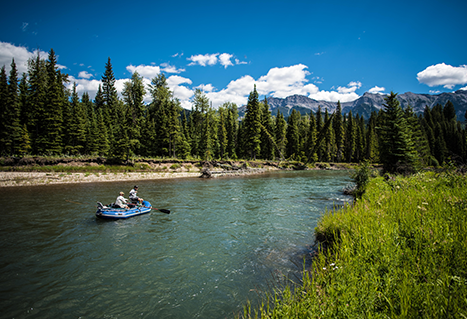

August
Bring fishing rods on your summer camping trip. There are plenty of hook-ups to be had in August.
- Coho start arriving in northern B.C. rivers.
- Pink salmon return in two-year cycles, with either odd years or even years having a dominant return. In odd-numbered years, pink salmon return to the Fraser River and other mainland systems beginning in late August. On the east coast of Vancouver Island, pink salmon return during even years. This is a great fishery for novice anglers and families; even a simple spinning rod with a lure can be used to catch these fish.
- If stream temperatures permit, try dry-fly fishing in rivers across the province, excluding southern Vancouver Island. Keep an eye on the in-season regulations for any stream closures.
- Sockeye salmon start to make an appearance. As sockeye populations are at risk in some areas, make sure to follow the salmon regulations, and handle fish with care. The Skeena and Babine rivers in northern B.C., along with the Stamp/Somass River on Vancouver Island, often allow a retention fishery.
- Chinook also start to show up in southern B.C.
- In big lakes, fish descend deeper during the summer to find cooler water temperatures. Troll with a downrigger to get your presentation down to where the fish are.
- Bass fishing is also a good option in the height of summer.
- August is a great month to hike to a high-alpine lake for some dry-fly fishing. Helicopters are used to stock many backcountry lakes with rainbow trout, creating a fun fishery for those willing to put in the effort to get there!
September
September’s cooler temperatures signal the start of autumn fishing. While usually less crowded than the busy spring season, the fall fishery can be just as productive.
- Coho and chum arrive in the rivers of Vancouver Island, Squamish, the Lower Mainland, and the Fraser Valley.
- Fly-fishing for rainbow and cutthroat trout in Vancouver Island streams opens again on September 1.
- The famed summer-run steelhead begin to arrive on the north and central coast in July, and the fishery lasts through early November. The Dean and Skeena rivers usually have returns of steelhead that are healthy enough to support recreational fishing (see Dean River draw).
- Consider a trip to the Fraser River for a chance to do battle with a huge white sturgeon. This is our province’s only catch-and-release fishery for sturgeon.
- Rainbow trout fishing in Interior lakes starts to heat up during the third week of September, and lasts until the ice comes on.
- Some streams in Region 4 close for bull trout spawning. In other streams, use egg patterns, dry flies, and streamers to target cutthroat trout and whitefish. Fall is an excellent time to fish for trout with egg patterns on any salmon- or kokanee-bearing stream that is open for fishing.
October
It’s salmon season in coastal B.C.! Plus, fall stocking of catchable-sized trout creates some urban fishing fun.
- Runs of chum, coho, and chinook salmon often peak in October.
- Open-water fishing continues through to the end of the month in the Interior and the north. Check out one of the many productive lakes in the Cariboo region for spectacular fall fishing.
- Lower Mainland and Vancouver Island lakes are stocked with catchable-sized fish by the Freshwater Fisheries Society of BC. Keep an eye on the online stocking reports, and hit these lakes before it gets too cold.
- In the Kootenays, October is a peak month to target bull trout with streamers, which imitate their kokanee prey.
- Late season dry-fly fishing on many streams extends to the end of this month.
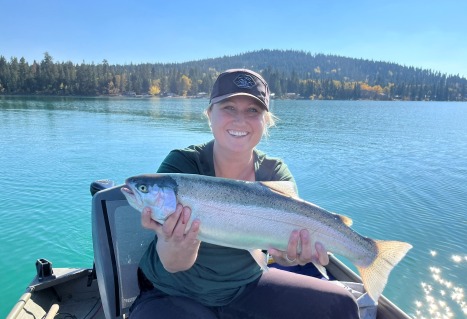
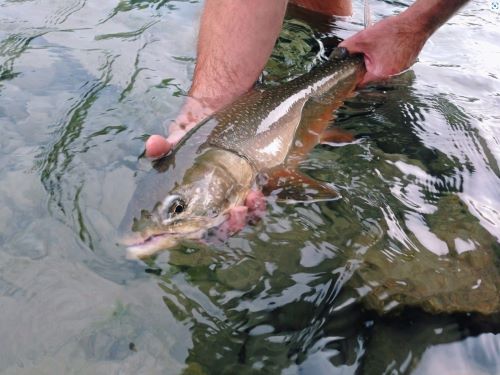
November
Stillwater fishing ends, and salmon fishing is winding down. Early ice-fishing may start in northern B.C.
- Egg eaters, like cutthroat and bull trout, are feasting on the remains from salmon runs.
- You can fish for bull trout in the Lower Mainland and Kootenays. By November, bull trout have finished spawning, and are hungry! In coastal rivers they feed on salmon eggs.
- Trolling in large bodies of water like the Arrow Lakes in the Kootenays can yield some big rainbow, lake, and bull trout.
- Depending on temperatures, ice-fishing can start as early as November in northern regions of the province. Lake trout, burbot, walleye, northern pike, and yellow perch are some of the species that can be caught through the ice.
December
Set some time aside during the festive season to go fishing!
- Ice-fishing is a perfect family-friendly activity once a lake’s waters freeze. As soon as the ice is thick enough (10 cm, or four inches, to be safe for solo anglers), it can be a great time to get out ice-fishing for brook and rainbow trout and kokanee. Since the water is still relatively warm In December, fish will be actively feeding and eager to take bait.
- In coastal rivers, there is good fishing for trout and char that feed on salmon eggs and the flesh of dead salmon.
With all these options, some planning, and good weather, you can be fishing twelve months of the year!
Species distribution will influence anglers’ choices on where and when to fish, too. Arctic char, for example, are only found in northern B.C., while some anadromous salmonids can only be found in coastal rivers.
Regulations and fishing openings and closures will influence what fishing is available as well. Some species (like walleye, bass, and burbot) are closed to fishing in certain regions (with some waterbody exceptions). Check the freshwater fishing regulations to see which gamefish can be targeted in each region, and any seasonal closures of fishing areas. Salmon runs fluctuate year-to-year; the Department of Fisheries and Oceans Canada website should be checked to see which recreational fisheries are open. You can purchase your non-tidal fishing licence online, or at participating vendor locations.
Happy fishing!
Author: Jessica Greinke, Freshwater Fisheries Society of BC
